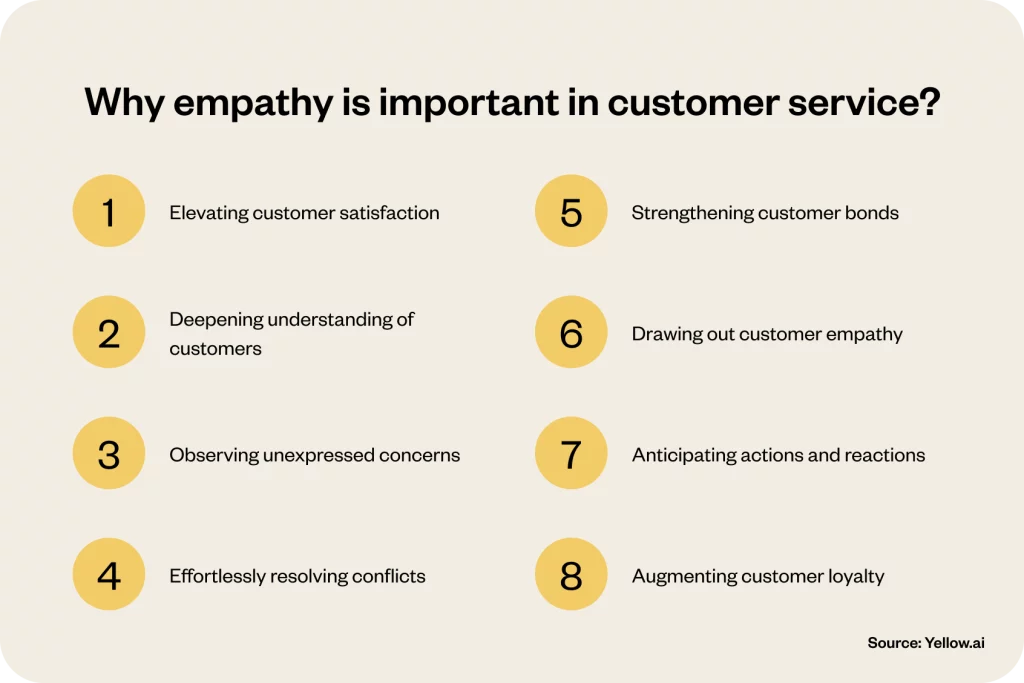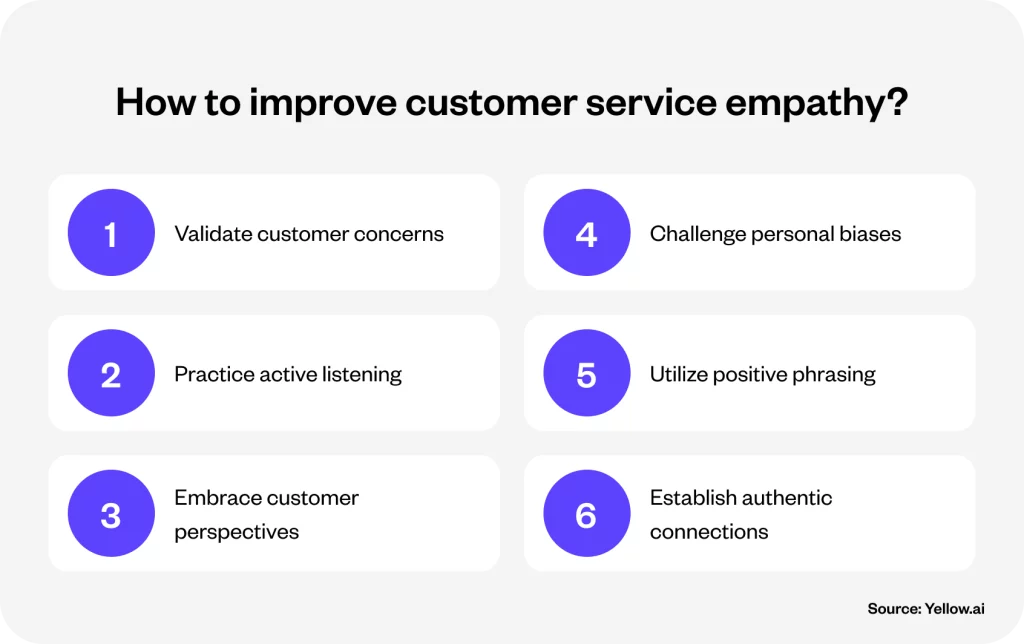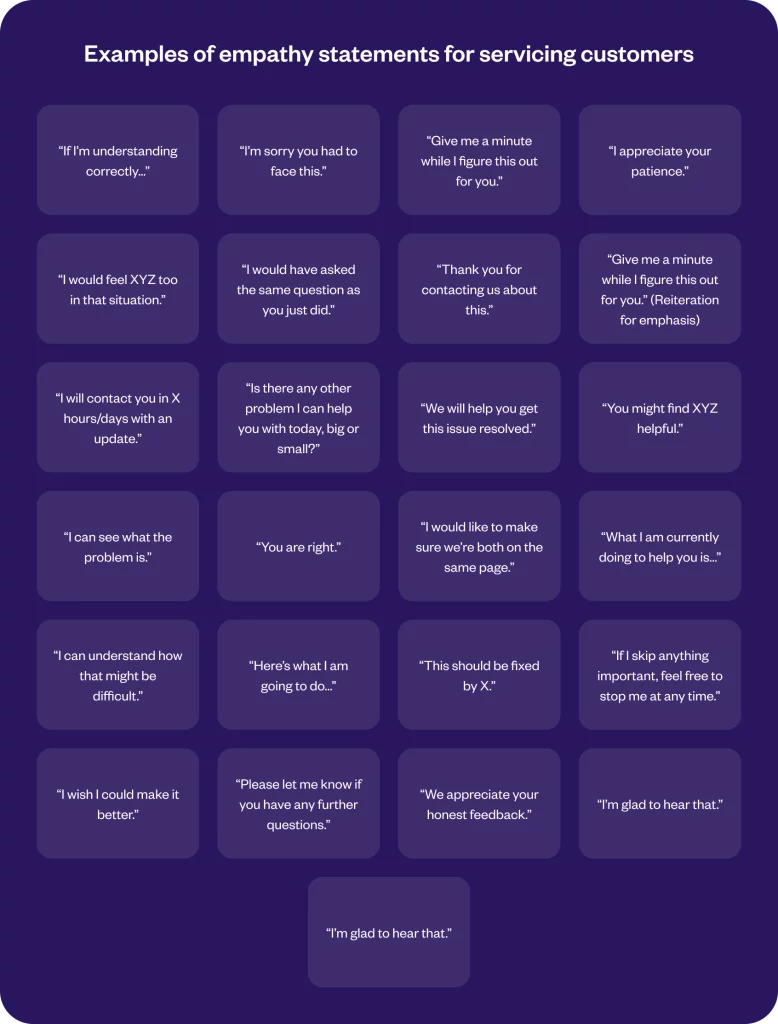Executive summary
Unlock the power of empathy in customer service, a crucial element that defines the success of customer interactions. This blog explores the concept of empathy, its importance in service excellence, and practical tips for implementation. Learn why empathy is vital for nurturing customer relationships and how it can significantly elevate service standards, with strategies to embed genuine understanding and connection in every customer interaction.
Imagine a scenario where two customers face identical issues, but their experiences diverge wildly based on the empathy shown by the service representatives. One customer leaves the interaction frustrated and unheard, while the other feels valued and understood, thanks to the empathetic approach of the service team. This divergence underscores the transformative power of empathy in customer service. It can turn potential conflicts into moments of connection and trust.
Empathy extends beyond mere problem-solving; it involves genuinely understanding and reflecting on the customer’s feelings and perspectives. In a digital age where automated responses are the norm, infusing genuine empathy into customer interactions can significantly differentiate a business, making customers feel genuinely seen and heard. A staggering 61% of consumers have ceased purchasing from businesses when competitors offer superior empathetic experiences, underscoring the profound impact of emotional connection beyond the product itself. Empathy is about resolving issues and building a loyal customer base to ensure that businesses meet customer expectations in every interaction.
Related must-reads:
- Customer service automation: Benefits and examples
- Omnichannel customer service – [Strategy + Examples]
- The complete guide to customer service best practices
- 10 Key elements of effective customer service
What is empathy in customer service?
Empathy in customer service transcends the mere transactional nature of answering queries or solving problems; it is about genuinely understanding and sharing the feelings of the customer. It’s the art of seeing things from the customer’s perspective, acknowledging their emotions, and addressing their needs in a considerate, respectful manner. This empathetic approach goes beyond just fixing an issue—it’s about connecting with the customer on a human level, showing that their feelings and experiences are valued and understood.
In the context of customer service, empathy involves actively listening to the customer, comprehending the nuances of their situation, and responding in a way that demonstrates a genuine understanding of their concerns. It’s not about having the perfect solution every time but about ensuring the customer feels heard, respected, and valued. By practicing empathy, service representatives can forge deeper connections, turning potentially negative experiences into positive interactions.
For businesses, embedding empathy into customer service practices is not just a nice-to-have; it’s a strategic imperative. It’s the bridge that turns customer interactions from routine transactions into meaningful experiences, fostering loyalty and trust. In today’s competitive marketplace, where products and services are often similar, offering empathetic customer service can be the distinguishing factor that sets a business apart, turning casual customers into lifelong advocates.
Why empathy is important in customer service?
Empathy in customer service is pivotal for fostering a deeper connection with customers, going beyond transactional interactions to create meaningful experiences. This emotional intelligence component is crucial because it directly influences customer perception and loyalty. Let’s explore why empathy is so integral to customer service.

1. Elevating customer satisfaction
Empathy directly correlates with customer satisfaction. When service agents demonstrate understanding and concern for customers’ feelings, it personalizes the customer experience, making them feel valued and respected. This emotional connection can significantly enhance customer satisfaction levels, leading to positive feedback and increased brand loyalty.
Related read: What is a CSAT score? – How is CSAT measured + How to improve
2. Deepening understanding of customers
Empathetic customer service enables agents to grasp the underlying issues and emotions customers face. This deeper understanding goes beyond surface-level interactions, allowing for more personalized and effective solutions. It’s about seeing the issue from the customer’s perspective and tailoring responses to address their specific concerns and needs.
3. Observing unexpressed concerns
Empathy allows agents to pick up on subtle cues and unvoiced issues during interactions. Recognizing these underlying concerns can lead to proactive service, where solutions are offered before the customer fully articulates the problem, enhancing the overall service experience.
Related read: AI Agents: Types, Benefits and Examples
4. Effortlessly resolving conflicts
Empathy plays a crucial role in conflict resolution. By understanding and acknowledging the customer’s perspective, agents can defuse potentially volatile situations, turning confrontations into constructive dialogues. Besides resolving the immediate issue, it also strengthens the customer’s trust in the brand.
5. Strengthening customer bonds
Demonstrating empathy helps build stronger relationships with customers. It shows that the company cares about them as individuals, not just as transactions. These stronger emotional bonds can translate into long-term loyalty and advocacy for the brand.
6. Drawing out customer empathy
When service agents are empathetic, customers are more likely to respond in kind. This mutual understanding can make it easier to navigate difficult conversations and find mutually agreeable solutions, enhancing the overall service interaction.
7. Anticipating actions and reactions
An empathetic approach enables service agents to anticipate customer needs and responses, leading to more efficient and effective service delivery. By understanding the customer’s perspective, agents can foresee potential questions or issues, allowing them to address these proactively.
8. Augmenting customer loyalty
Empathy contributes to creating memorable service experiences that foster customer loyalty. When customers feel understood and valued, they are more likely to remain loyal to the brand, recommend it to others, and become long-term advocates.
Related read: Customer loyalty: Importance & Strategies to increase
How to improve customer service empathy?
Improving empathy in customer service is a strategic approach to deepen customer relationships and enhance their experience with your brand. Here are six actionable strategies to elevate empathy in your customer service:

1. Validate customer concerns
Acknowledging and validating customer concerns is the first step in demonstrating empathy. This approach reassures customers that their feelings and experiences are understood and taken seriously. By actively acknowledging their issues, you build a foundation of trust and open communication, which is essential for resolving any customer service interaction positively.
- Listen actively: Pay close attention to the customer’s words, tone, and emotions to fully understand their concern.
- Acknowledge their feelings: Use phrases like “I can see why that would be frustrating” to show understanding.
- Affirm their experience: Confirm that their feelings are valid and that you are there to help resolve their issues.
2. Practice active listening
Active listening involves fully concentrating on what the customer is saying, understanding their message, responding thoughtfully, and remembering the information. This technique helps identify the root cause of the customer’s issue and provides a tailored solution that addresses their specific needs.
- Reflect and clarify: Summarize what the customer has said to ensure you have understood them correctly.
- Ask open-ended questions: Encourage a deeper conversation to get a complete picture of the situation.
- Show engagement: Use verbal affirmations and nonverbal cues (like nodding if you’re on a video call) to show you are engaged and interested.
3. Embrace customer perspectives
Stepping into your customers’ shoes to view the situation from their perspective enhances empathy. This shift in viewpoint allows for a more personalized and compassionate approach to addressing their concerns, leading to better problem-solving and customer satisfaction.
- Imagine yourself as the customer: Consider how you would feel and what you would expect in their situation.
- Avoid assumptions: Each customer’s experience is unique; don’t assume their feelings or reactions.
- Tailor your approach: Adjust your response based on the customer’s emotional state and needs.
4. Challenge personal biases
Recognizing and challenging personal biases is crucial in providing unbiased and empathetic customer service. By being aware of and actively addressing these biases, customer service representatives can ensure fair and empathetic interactions with all customers.
- Be self-aware: Regularly reflect on your interactions to identify any bias.
- Seek diverse perspectives: Engage with colleagues from different backgrounds to broaden your understanding.
- Focus on individuality: Treat each customer as an individual, avoiding stereotypes or generalizations.
5. Utilize positive phrasing
Positive language can transform customer interactions, turning potential conflicts into constructive conversations. It’s about reframing responses in a way that focuses on solutions and positive outcomes, even in challenging situations.
- Highlight solutions: Focus on what can be done rather than what can’t.
- Maintain a positive tone: Use words that convey hope and willingness to assist.
- Avoid negative language: Avoid words that convey refusal, such as “can’t” or “won’t.”
6. Establish authentic connections
Personalizing interactions by finding common ground or sharing experiences can create genuine connections with customers. These connections make interactions more pleasant and memorable, contributing to a positive perception of the customer service experience.
- Personalize your approach: Use the customer’s name and reference any past interactions.
- Share relevant experiences: If appropriate, sharing a brief personal story similar to the customer’s situation can build rapport.
- Be genuine: Authenticity in communication fosters trust and strengthens the customer relationship.
Examples of empathy statements for servicing customers
Empathy statements in customer service are key phrases that convey understanding, respect, and compassion to the customer. Here are top empathy statements with explanations and their significance in fostering positive customer interactions:

1. “If I’m understanding correctly…”
This statement helps ensure that you have correctly grasped the customer’s issue, promoting mutual understanding. By reflecting the customers’ concerns back to them, you demonstrate active listening and reassure them that they are being heard accurately. It can build trust and facilitate a more focused and effective problem-solving process.
2. “I’m sorry you had to face this.”
Apologizing to a customer shows empathy and acknowledgment of their inconvenience or frustration, regardless of fault. It’s about expressing regret for the customer’s negative experience and signaling that you are on their side, ready to assist in finding a resolution. This acknowledgment can be the first step in repairing the customer relationship and paving the way for a positive interaction.
3. “Give me a minute while I figure this out for you.”
This phrase communicates your commitment to actively solving the customer’s problem and conveys that their issue is being taken seriously. It also respects the customer’s time by informing them that you are working diligently on their behalf. It can help to alleviate frustration and establish patience during the resolution process.
4, “I appreciate your patience.”
Recognizing a customer’s patience during a service interaction acknowledges the inconvenience they may be experiencing and values their time. This statement can diffuse tension and foster a more cooperative atmosphere, enhancing the customer’s overall experience with your service.
5. “I would feel XYZ too in that situation.”
Expressing shared emotions or understanding how the customer feels in their situation creates a personal connection and shows genuine empathy. It validates the customer’s feelings, making them feel seen and understood, which can significantly improve the customer service experience.
6. “I would have asked the same question as you just did.”
This statement validates the customer’s inquiry, making them feel sensible and valued for their curiosity or concern. It reassures the customer that their question is important and encourages open communication. This approach fosters a more relaxed and honest dialogue, where the customer feels comfortable expressing their needs or doubts.
7. “Thank you for contacting us about this.”
Expressing gratitude for the customer’s decision to reach out emphasizes the value of their feedback or concern. It signifies that the company appreciates the opportunity to address and resolve issues, reinforcing the importance of the customer’s experience and contributing to a positive perception of customer service.
8. “Give me a minute while I figure this out for you.” (Reiteration for emphasis)
Reiterating the commitment to solving the customer’s problem highlights the dedication to service and the importance placed on their satisfaction. It assures the customer of a proactive and responsible approach to their issue, demonstrating that their concern is a priority.
9. “I will contact you in X hours/days with an update.”
Setting a clear expectation for follow-up provides transparency and builds trust. This statement shows that the company is organized, reliable, and committed to keeping the customer informed, which can significantly enhance the customer’s sense of security and value.
10. “Is there any other problem I can help you with today, big or small?”
This open-ended question communicates willingness and readiness to assist further, regardless of the issue’s scale. It encourages the customer to voice additional concerns they might have, ensuring that all their needs are addressed comprehensively, enhancing the thoroughness and thoughtfulness of the customer service experience.
11. “We will help you get this issue resolved.”
This statement assures the customer of the company’s commitment to solving their problem, conveying a sense of teamwork and support. It implies that the customer is not alone in facing the issue and that the company is actively working towards a resolution, which can alleviate stress and build trust.
12. “You might find XYZ helpful.”
Offering suggestions or solutions tailored to the customer’s situation shows that the service agent is thinking proactively about their needs. This statement also gives the customer options, empowering them to choose what works best for them, thereby enhancing the personalized experience.
13. “I can see what the problem is.”
Acknowledging that the issue is understood demonstrates competence and attentiveness. It reassures the customer that they are being heard and that their concern is being taken seriously, paving the way for a solution-focused conversation.
14. “You are right.”
Affirming the customer’s point of view or feelings validates their experience and can diffuse tension. It shows respect for their perspective and can help build a cooperative relationship, making the problem-solving process more collaborative.
15. “I would like to make sure we’re both on the same page.”
This statement emphasizes the importance of clear communication and mutual understanding in customer service interactions. It invites clarification and confirms that both parties have a shared understanding of the situation, which is crucial for effective problem resolution.
16. “What I am currently doing to help you is…”
This statement keeps the customer informed about the actions being taken to resolve their issue. It shows transparency and reassures the customer that their concern is being addressed actively, which can help build trust and reduce anxiety.
17. “I can understand how that might be difficult.”
Expressing understanding of the customer’s difficulties demonstrates empathy and validation of their feelings. It shows the customer that their emotions are recognized and considered, contributing to a more empathetic and connected interaction.
18. “Here’s what I am going to do…”
Providing a clear action plan shows initiative and responsibility. It reassures the customer that there is a structured approach to solving their problem, demonstrating both competence and care in handling their issue.
19. “This should be fixed by X.”
Setting a clear timeline for resolution shows commitment and accountability. It provides the customer with a concrete expectation of when their issue will be addressed, helping to build trust and reduce uncertainty.
20. “If I skip anything important, feel free to stop me at any time.”
Inviting customers to interrupt or ask questions during the conversation demonstrates respect for their input and ensures their concerns are fully addressed. It encourages open communication and ensures that the service is tailored to their needs.
21. “I wish I could make it better.”
Expressing a genuine desire to improve the customer’s situation shows empathy and understanding. It communicates that the customer’s satisfaction is a priority, even if the immediate solution is limited.
22. “Please let me know if you have any further questions.”
This statement encourages ongoing communication and signifies that the customer’s understanding and comfort are important. It shows a willingness to continue providing support and ensures that the customer feels valued and heard.
23. “We appreciate your honest feedback.”
Acknowledging the value of customer feedback shows that the company is open to learning and improvement. It signals that customer input is a critical part of enhancing service and products.
24. “I’m glad to hear that.”
Responding positively to customer feedback or comments creates a pleasant and affirmative communication atmosphere. It reinforces positive interactions and encourages continued engagement with the company.
25. “Have we covered everything you wanted to discuss today?”
This closing question ensures that all the customer’s concerns have been addressed and leaves the conversation open for any additional topics. It demonstrates thoroughness and a commitment to complete customer satisfaction.
How does Yellow.ai enhance empathy in customer service?
Transitioning from traditional customer service models to an empathetic, automated system, Yellow.ai stands at the forefront of revolutionizing customer interactions. By integrating advanced AI technology, Yellow.ai enhances empathy in customer service automation, ensuring that customers feel understood and valued, even in automated interactions. Here’s how Yellow.ai makes a difference:
- Dynamic AI-powered chatbots: Yellow.ai’s chatbots are designed to understand and mimic human emotions, providing responses that resonate with customers on a personal level.
- Sentiment analysis tools: By analyzing the tone and context of customer inquiries, Yellow.ai identifies emotional cues and tailors responses accordingly, ensuring that each interaction feels personal and empathetic.
- Omnichannel support: Yellow.ai offers consistent and seamless empathetic responses across all communication channels, ensuring customers receive the same level of understanding and support, regardless of how they reach out.
- Personalized customer experiences: Yellow.ai leverages customer data and provides customized interactions, showing customers that their preferences and history are considered in every interaction.
- Proactive customer engagement: Anticipating customer needs and initiating supportive conversations, Yellow.ai’s solutions foster a proactive approach to customer service, enhancing customer satisfaction and loyalty.
Interested in enhancing your customer service with empathy-driven automation? Book a demo with Yellow.ai today and transform your customer interactions.
Key takeaways
Empathy in customer service is more than a soft skill; it’s a strategic asset that shapes memorable customer experiences and fosters brand loyalty. In an era where customer expectations are ever-evolving, the ability to understand and empathize with customers is what sets leading businesses apart. As we harness technology like AI and analytics, the fusion of human empathy and digital efficiency opens new avenues for customer service excellence, ensuring that every customer interaction is not just heard but truly understood.
Looking ahead, the integration of empathy in customer service will continue to be a defining factor in building strong, lasting customer relationships. It’s not just about addressing immediate concerns but about creating an environment where customers feel genuinely cared for, valued, and respected. This empathetic approach, combined with innovative technologies, paves the way for a future where customer service transcends mere transactions to become a cornerstone of customer loyalty and business success.
Frequently asked questions (FAQs)
How does empathy impact customer satisfaction?
Empathy significantly impacts customer satisfaction by making customers feel valued and understood. When service representatives show empathy, they address not just the practical aspects of a customer’s issue but also the emotional side, leading to a more satisfying and complete service experience.
Can empathy be taught to customer service representatives?
Yes, empathy can be taught and developed through training programs that focus on active listening, understanding customer perspectives, and practicing emotional intelligence. Role-playing exercises and feedback can also help representatives learn how to convey empathy effectively.
What are the challenges of showing empathy in customer service?
Challenges include managing high volumes of customer interactions without sacrificing the quality of empathetic responses, ensuring consistency across all service channels, and training staff to recognize and appropriately respond to a range of emotions.
How does empathy in customer service affect customer loyalty?
Empathy in customer service fosters stronger relationships, leading to increased customer loyalty. Customers who feel understood and appreciated are more likely to remain loyal to a brand, make repeat purchases, and recommend the company to others.
How can technology help in conveying empathy to customers?
Technology like AI chatbots and sentiment analysis tools can help recognize customer emotions and deliver personalized, empathetic responses. These tools can analyze customer language and feedback to tailor interactions that resonate with their feelings and needs.
What strategies can managers use to foster empathy among their teams?
Managers can foster empathy by encouraging open communication, providing empathy training, recognizing and rewarding empathetic interactions, and creating a supportive work environment that prioritizes understanding and addressing customer emotions.





















